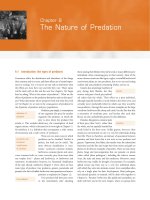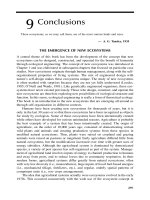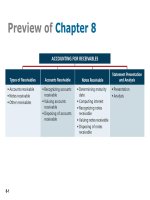Lecture Accounting principles (8th edition) – Chapter 9: Accounting for receivables
Bạn đang xem bản rút gọn của tài liệu. Xem và tải ngay bản đầy đủ của tài liệu tại đây (551.69 KB, 48 trang )
Chapter
9-1
CHAPTER 9
ACCOUNTING FOR
RECEIVABLES
Accounting Principles, Eighth Edition
Chapter
9-2
Study Objectives
Study Objectives
1.
Identify the different types of receivables.
2.
Explain how companies recognize accounts receivable.
3.
Distinguish between the methods and bases companies use to value accounts
receivable.
4.
Describe the entries to record the disposition of accounts receivable.
5.
Compute the maturity date of and interest on notes receivable.
6.
Explain how companies recognize notes receivable.
7.
Describe how companies value notes receivable.
8.
Describe the entries to record the disposition of notes receivable.
9.
Explain the statement presentation and analysis of receivables.
Chapter
9-3
Accounting for Receivables
Accounting for Receivables
Types
Typesof
of
Receivables
Receivables
Accounts
Accounts
Receivable
Receivable
Notes
Notes
Receivable
Receivable
Accounts
receivable
Notes
receivable
Other
receivables
Recognizing
accounts
receivable
Valuing
accounts
receivable
Disposing of
accounts
receivable
Determining
maturity date
Computing
interest
Recognizing
notes
receivable
Valuing notes
receivable
Disposing of
notes
receivable
Chapter
9-4
Statement
Statement
Presentation
Presentation
and
andAnalysis
Analysis
Presentation
Analysis
Types of Receivables
Types of Receivables
Amounts due from individuals and other companies that are expected to
be collected in cash.
Amounts owed by
customers that result
from the sale of goods
and services.
Claims for which
formal instruments of
credit are issued
as proof of debt.
“Nontrade” (interest,
loans to officers,
advances to employees,
and income taxes
refundable).
Accounts
Accounts
Receivable
Receivable
Notes Receivable
Notes Receivable
Other
Other
Receivables
Receivables
Chapter
9-5
LO 1 Identify the different types of receivables.
Accounts Receivable
Accounts Receivable
Three accounting issues:
1. Recognizing accounts receivable.
2. Valuing accounts receivable.
3. Disposing of accounts receivable.
Recognizing Accounts Receivable
The following exercise was illustrated in Chapter 5. For simplicity,
inventory and cost of goods sold have been omitted.
Chapter
9-6
LO 1 Identify the different types of receivables.
Recognizing Accounts Receivable
Recognizing Accounts Receivable
E55 Presented are transactions related to Wheeler Company.
E55
1. On December 3,Wheeler Company sold $500,000 of merchandise to Hashmi Co.,
terms 2/10, n/30, FOB shipping point.
2. On December 8, Hashmi Co. was granted an allowance of $27,000 for
merchandise purchased on December 3.
3. On December 13,Wheeler Company received the balance due from Hashmi Co.
Instructions: Prepare the journal entries to record these transactions on the books
of Wheeler Company using a perpetual inventory system.
Chapter
9-7
LO 2 Explain how companies recognize accounts receivable.
Recognizing Accounts Receivable
Recognizing Accounts Receivable
E55 Prepare the journal entries for Wheeler Company .
E55
1. On December 3, Wheeler Company sold $500,000 of merchandise to
Hashmi Co., terms 2/10, n/30, FOB shipping point.
Dec. 3
Chapter
9-8
Accounts receivable
Sales
500,000
500,000
LO 2 Explain how companies recognize accounts receivable.
Recognizing Accounts Receivable
Recognizing Accounts Receivable
E55 Prepare the journal entries for Wheeler Company.
E55
2. On December 8, Hashmi Co. was granted an allowance of $27,000 for
merchandise purchased on December 3.
Dec. 8
Chapter
9-9
Sales returns and allowances
Accounts receivable
27,000
27,000
LO 2 Explain how companies recognize accounts receivable.
Recognizing Accounts Receivable
Recognizing Accounts Receivable
E55 Prepare the journal entries for Wheeler Company .
E55
3. On December 13, Wheeler Company received the balance due from Hashmi
Co.
Dec. 13
Cash
463,540 ***
Sales discounts
Accounts receivable
*
9,460 **
473,000 *
($500,000 – $27,000)
** [($500,000 – $27,000) X 2%]
*** ($473,000 – $9,460)
Chapter
9-10
LO 2 Explain how companies recognize accounts receivable.
Accounts Receivable
Accounts Receivable
Valuing Accounts Receivables
Are reported as a current asset on the balance sheet.
Are reported at the amount the company thinks they will be able
to collect.
Sales on account raise the possibility of accounts not being
collected.
Valuation can be difficult because an unknown amount of
receivables will become uncollectible.
Chapter
9-11
LO 3 Distinguish between the methods and bases companies use to
value accounts receivable.
Valuing Accounts Receivable
Valuing Accounts Receivable
Methods of Accounting for Uncollectible Accounts
Direct WriteOff
Theoretically undesirable:
no matching.
receivable not stated at net
realizable value.
not acceptable for financial
reporting.
Chapter
9-12
Allowance Method
Losses are estimated:
better matching.
receivable stated at net realizable
value.
required by GAAP.
LO 3 Distinguish between the methods and bases companies use to
value accounts receivable.
Presentation of Accounts Receivable
Presentation of Accounts Receivable
Assets
Current Assets:
Cash
Accounts receivable
Less: Allowance for doubtful accounts
Merchandise inventory
Prepaid expenses
Total current assets
Chapter
9-13
500
25
$ 346
475
812
40
1,673
LO 3 Distinguish between the methods and bases companies use to
value accounts receivable.
Presentation of Accounts Receivable
Presentation of Accounts Receivable
Assets
Current Assets:
Cash
Accounts receivable, net of $25 allowance
for doubtful accounts
Merchandise inventory
Prepaid expenses
Total current assets
Chapter
9-14
$ 346
475
812
40
1,673
LO 3 Distinguish between the methods and bases companies use to
value accounts receivable.
Valuing Accounts Receivable
Valuing Accounts Receivable
Allowance Method for Uncollectible Accounts
1. Companies estimate uncollectible accounts receivable.
2. To record estimated uncollectibles, companies debit Bad Debts
Expense and credit Allowance for Doubtful Accounts (a contra
asset account).
3. When companies write off specific uncollectible accounts, they debit
Allowance for Doubtful Accounts and credit Accounts Receivable.
Chapter
9-15
LO 3 Distinguish between the methods and bases companies use to
value accounts receivable.
Valuing Accounts Receivable
Valuing Accounts Receivable
E96 On December 31, 2008, Jarnigan Co. estimated that 2% of its net sales
E96
of $400,000 will become uncollectible. The company recorded this amount as
an addition to Allowance for Doubtful Accounts. On May 11, 2009,
Jarnigan Co. determined that Terry Frye’s account was uncollectible and
wrote off $1,100. On June 12, 2009, Frye paid the amount previously
written off.
Instructions
Prepare the journal entries on December 31, 2008, May 11, 2009, and June
12, 2009.
Chapter
9-16
LO 3 Distinguish between the methods and bases companies use to
value accounts receivable.
Valuing Accounts Receivable
Valuing Accounts Receivable
E96 Prepare the journal entries on December 31, 2008, May 11, 2009, and
E96
June 12, 2009.
December 31 ($400,000 x 2% = 8,000)
Bad debt expense
8,000
Allowance for doubtful accounts 8,000
Chapter
9-17
LO 3 Distinguish between the methods and bases companies use to
value accounts receivable.
Valuing Accounts Receivable
Valuing Accounts Receivable
E96 Prepare the journal entries on December 31, 2008, May 11, 2009, and
E96
June 12, 2009.
May 11 (writeoff)
Allowance for doubtful accounts
Accounts receivable
1,100
June 12 (recovery)
Accounts receivable
Allowance for doubtful accounts1,100
1,100
Cash
Accounts receivable
Chapter
9-18
1,100
1,100
1,100
LO 3 Distinguish between the methods and bases companies use to
value accounts receivable.
Valuing Accounts Receivable
Valuing Accounts Receivable
Bases Used for Allowance Method
Chapter
9-19
Illustration 95
LO 3 Distinguish between the methods and bases companies use to
value accounts receivable.
Valuing Accounts Receivable
Valuing Accounts Receivable
Example Data
Credit sales
$500,000
Estimated % of credit sales uncollectible
1.25%
Accounts receivable balance
$72,500
Estimated % of A/R not collected
8%
Unadjusted balance in Allowance for Doubtful Accounts:
Case 1
$150 (credit balance)
Case 2 $150 (debit balance)
Chapter
9-20
LO 3 Distinguish between the methods and bases companies use to
value accounts receivable.
Valuing Accounts Receivable
Valuing Accounts Receivable
Percentage of Sales – disregards the existing balance in
Allowance for Doubtful Accounts
Credit sales
$500,000
Estimated percentage uncollectible
1.25%
Estimated bad debt expense
$ 6,250
Journal entry:
Bad debt expense 6,250
Allowance for doubtful accounts 6,250
Chapter
9-21
LO 3 Distinguish between the methods and bases companies use to
value accounts receivable.
Valuing Accounts Receivable
Valuing Accounts Receivable
Percentage of Sales
Case 1
Case 2
Actual balance (credit)
(150)
150
Estimated uncollectible
(6,250)
(6,250)
Ending balance
(6,400)
(6,100)
The Allowance for Doubtful Accounts has an ending balance of
$6,400 in Case 1 and $6,100 in Case 2.
Chapter
9-22
LO 3 Distinguish between the methods and bases companies use to
value accounts receivable.
Valuing Accounts Receivable
Valuing Accounts Receivable
Percentage of Receivables
Accounts receivable
$ 72,500
Estimated percentage uncollectible
x 8%
Required balance in allowance account
$ 5,800
==================================================
=
What will be the amount of the adjusting entry?
Chapter
9-23
LO 3 Distinguish between the methods and bases companies use to
value accounts receivable.
Valuing Accounts Receivable
Valuing Accounts Receivable
Percentage of Receivables
Case 1
Actual balance (credit)
Case 2
(150)
150
Desired balance
(5,800)
(5,800)
Adjustment
(5,650)
(5,950)
Journal entry – Case 1:
Bad debt expense
5,650
Allowance for doubtful accounts
Chapter
9-24
5,650
LO 3 Distinguish between the methods and bases companies use to
value accounts receivable.
Valuing Accounts Receivable
Valuing Accounts Receivable
Percentage of Receivables
Case 1
Actual balance (credit)
Case 2
(150)
150
Desired balance
(5,800)
(5,800)
Adjustment
(5,650)
(5,950)
Journal entry – Case 2:
Bad debt expense
5,950
Allowance for doubtful accounts
Chapter
9-25
5,950
LO 3 Distinguish between the methods and bases companies use to
value accounts receivable.









